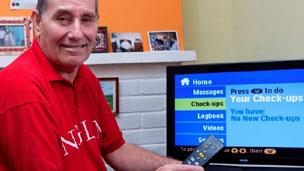Health care by TV and remote control
- Published

Terry Munro manages his diabetes via his television, using a special remote control
First thing in the morning, Terry Munro always puts the kettle on.
"Then I take my blood sugar, take my blood pressure and my weight and in that time the kettle's boiled.
"And I've got a record of it on my TV. It's marvellous, it really is."
Terry, who is 67 years old and has diabetes, has been keeping tabs on his own health using nothing more than his television.
The testing equipment uses Bluetooth so when Terry has taken his daily measurements they are automatically uploaded to the TV.
A trained nurse can access and monitor the readings from a central location and make decisions about potential changes in treatments.
"I like walking, but I used to go out and go hypo. Now I know I can't go out if my blood sugar is too low, so I am more aware now.
"It's like having a doctor there all the time."
Terry is one of more than 3,000 people with diabetes, heart failure or COPD (a serious lung disease called chronic obstructive pulmonary disease) who took part in a recent two-year trial of telehealth technology for monitoring people who are chronically ill.
The trial focused on patients in Kent, Cornwall and the London Borough of Newham.
Yvonne Fenn, lead nurse for telehealth at East London NHS Foundation Trust in Newham, says patients like Terry are constantly being watched by nurses, albeit at a distance.
Any unusual readings entered onto the TV are picked up straight away.
"Any abnormal readings prompt a visit by a senior nurse or we can alert the patient's GP or find the answers by calling them up.
"For example, a patient with COPD may have an increase in pulse rate and that could prompt us to start them on a course of antibiotics earlier than would have been possible otherwise.
"We can see the signs of a problem before the patient even notices."
The idea is that this removes the need for the patient to attend a clinic or hospital appointment, saving everyone time and money.
Telehealth works particularly well for people with health conditions like diabetes, heart failure, COPD, arthritis and depression.
According to the results of the trial, published by the Department of Health, external, telehealth can reduce mortality, reduce the need for admissions to hospital, lower the number of days spent in a hospital bed and cut the time spent in A&E.
'Nurse on shoulder'
Yvonne Fenn said the effects of telehealth are educational too.
"It helps patients understand their disease better. They become more expert.
"When they used to go for hospital check-ups, information leaflets were often put in the bin, but because telehealth gives daily readings, these help to educate the patient and they stabilise more readily."
But telehealth does not always require a TV.
In Cornwall, patients in the trial used a little monitor the size of their palm which works using wireless technology.
On the Isles of Scilly, off Cornwall, the technology means that patients in remote communities can be monitored closely without having to travel long distances to see their GP.
Dave Tyas, telehealth manager for Peninsula Community Health in Cornwall, believes there are all sorts of potential uses for the technology. He has already started to tailor the technology for people at risk of urinary tract infections and at risk of falling at home.
"It's about bringing care closer to home," he says.
"It's evolving all the time, and we are continually evaluating things. But it's important to focus on what works. It has to benefit the individual."
But don't patients miss personal contact with their GP or specialist?
"This technology doesn't replace face-to-face visits. We are actually contacting them more regularly but just in a different way.
"As one patient said, it's like having a little nurse that sits on your shoulder."
- Published5 December 2011
- Published5 December 2011
- Published13 October 2011